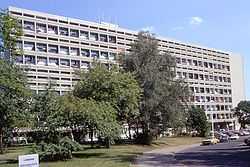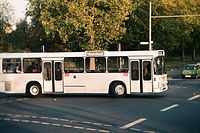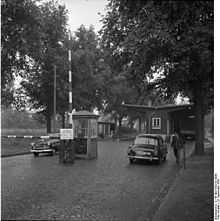Heerstraße (Berlin)

The Heerstraße runs from Theodor-Heuss-Platz in Berlin-Charlottenburg until the western city border of Berlin in the locality of Staaken in the borough of Spandau. In its intire length it is part of the Bundesstraße 5; from Theodor-Heuss-Platz to Wilhelmstraße it is also Bundesstraße 2. With its length of about 10 kilometres, it is one of the longest streets in Berlin and an important commuter route. The street is a five-laned expressway (Kraftfahrstraße), depending on traffic flow the middle lane is available during rush hours in the morning (eastbound) and in the evening (westbound).
History
Planning and construction
The construction of the street started in 1874 as chaussee from Berlin-Charlottenburg to Pichelsberg. In 1911 the street was opened in full length as Döberitzer Heerstraße in attendance of Emperor Wilhelm II.. It was constructed in stages since 1903. This all was in connection with the construction of a wide street for representation purposes, which started at the Berlin Castle as Unter den Linden Street to Ernst-Reuter-Platz. It was then extended via Bismarckstraße and Kaiserdamm with a slight bent at Scholzplatz. From 1920 on the name was shortened to Heerstraße.
Till 1964 the Heerstraße was also a tram route. The former tramway is today's green strip between Theodor-Heuss-Platz and Stößenseebrücke.
Routing
Theodor-Heuss-Platz to S-Bahnhof Heerstraße
The Heerstraße starts at Theodor-Heuss-Platz in Westend of Charlottenburg district, close to the exhibition ground, the Funkturm and the International Congress Centre (ICC).
In east-west direction it got houses till the S-Bahnhof Heerstraße. Until 30 March 1950 this part of the Heerstraße was still known as Kaiserdamm.
S-Bahnhof Heerstraße to Scholzplatz

From there the Heerstraße runs south of the Olympic Stadium and passes a former housing area (nicknamed "Little Britain") of the British Forces in Berlin. Close to Scholzplatz was also the British Military Hospital (BMH), what is today the Paulinen Hospital. South of the Heerstraße starts the Grunewald which stretches down to Wannsee.
Scholzplatz to Pichelsdorfer Straße
At Scholzplatz the Heerstraße makes a slight bent to the north-west. On the southern side is the Commonwealth War Cemetery, also known as Berlin War Cemetery, and the Jewish cemetery. Behind the cemetery is the 230-metre high Radiomast Scholzplatz of the public broadcaster RBB. Further west the Heerstraße crosses the Stößensee bridge, above the Havelchaussee and lake Stößensee. Also the Heerstraße reaches the district of Spandau here. At the 800 metre afterwards following Freybrücke, above the Havel river, is the Jordanian Embassy. Pichelsdorf comes then south of the Heerstraße and the lake Grimnitzsee in the north.
Pichelsdorfer Straße to Sandstraße

The Pichelsdorfer Straße runs from the Heerstraße northbound and connects from here to the Spandauer Altstadt (Oldtown).
Behind the Gatower Straße, where a lot of bus routes meet, is the location for the BVG bus depot Spandau (northern side).
At the afterwards following Wilhelmstraße the routing of the Bundesstraße 2 turns south into the Wilhelmstraße and connects with Potsdam. The routing of the Bundesstraße 5 remains on Heerstraße till the end. Also in Wilhelmstraße northbound are the former Smuts Barracks and still the former Britannia Centre Spandau, the location where Spandau Prison used to be.
Sandstraße to Bergstraße
The next crossing is the Sandstraße, which was until it was cut in the early 1970s, was leading to another housing area of the British Forces. The cut off part of the Sandstraße is known today as Leubnitzer Weg. The Sandstraße is also the beginning of the locality of Staaken.

Until around 1973 the next crossing after Sandstraße was Seeburger Weg and Magistratsweg. The Seeburger Weg crossed the Heerstraße in an soutwestbound angle. The Magistratsweg came from the north to end on Heerstraße as fifth end of this crossing.
With new blocks of houses being built right atop the Seeburger Weg between Heerstraße and Maulbeerallee, the southern end of the Seeburger Weg became known as Semmelländer Weg. It was then bent together with the Magistratsweg to become a new crossing, as it's known today.
The next interesting intersection is the Reimerweg, where the remaining half of the Tauentzienbrücke crosses the Heerstraße.
After Reimerweg, the Gärtnereiring branches off on the northern side to run parallel to the Heerstraße until close to the Bergstraße. This is because the Heerstraße customs checkpoint began there. Today the customs buildings are used by an observatory club.
Bergstraße to the city border

At the Bergstraße began the territory of East Germany. A few meters west of the Bergstraße was the Berlin Wall. The Checkpoint Heerstraße stretched in its latest stage as far as Weidenweg.
Close to its end, the Heerstraße is joined by the Nennhauser Damm which was in its northern end also the border between the SOZ/GDR with one half being GDR and the other half being West Berlin.
This final stretch of the Heerstraße connected together with the Nennhauser Damm to the Staaken Airfield until it was finally closed in the early 1950s. The airfield was briefly mentioned in the movie Battle of Britain. The airport buildings were later used as hospital. That's where ice skater Katarina Witt was born.
Further westbound
The continuing of the Heerstraße as Bundesstraße 5 in the Federal State of Brandenburg is named Hamburger Chaussee. It leads through the Havelland, crosses the Berlin Ring and runs via Hamburg right up to the Danish border. In Denmark it continues in Sæd as Primærrute 11 in Tønder Province up to Aalborg.
References
Coordinates: 52°30′48″N 13°11′43″E / 52.51333°N 13.19528°E